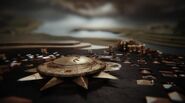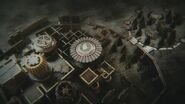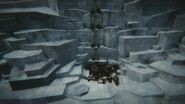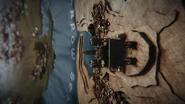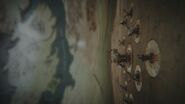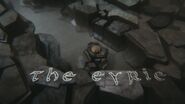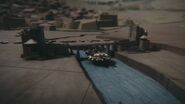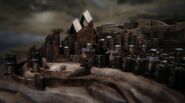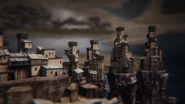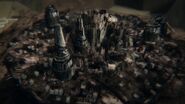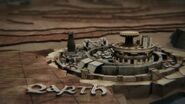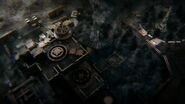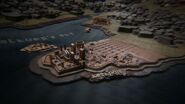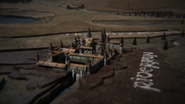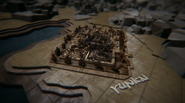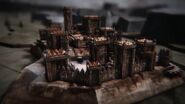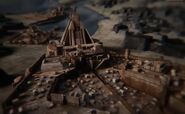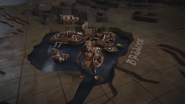[[Video:Game Of Thrones |thumb|350px|right|The title sequence for Game of Thrones.]] The Game of Thrones title sequence introduces every episode and changes depending on the locations visited in that particular episode.
Description
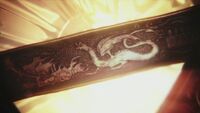
Relief detail showing the Doom of Valyria.
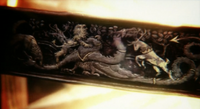
Relief detail showing Robert's Rebellion.
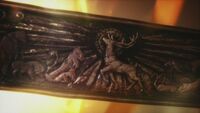
Relief detail depicting Robert Baratheon's victory.
The Game of Thrones title card.
The title sequence consists of a three-dimensional map of the world, with the continents of Westeros and Essos located on the inner surface of a sphere. At the center of the sphere is a light source, effectively a sun surrounded by an astrolabe-like arrangement of rotating rings. The details of the title sequence change each week depending on the locations visited. The following description is how the sequence appears in the first episode of the series, "Winter is Coming".
The sequence opens with a close-up of the sun and the astrolabe surrounding it. Relief details are visible on the astrolabe, showing a volcano destroying a city whilst a dragon watches on and several people escaping in a boat, a reference to the Doom of Valyria. The camera then pans to a wide-shot of Westeros and Essos before zooming in on the city of King's Landing, in particular the sigil of House Baratheon on what appears to be a large gear in the middle of the city. The gear begins turning, moving other cogs, and then three-dimensional buildings start rising out of the ground, such as the Red Keep and the Great Sept of Baelor.
Once the city is assembled, the camera moves north across Westeros to Winterfell, which similarly rises out of the ground whilst a gear bearing the sigil of House Stark rotates. The camera pays particular attention to the godswood of Winterfell and its heart tree as it rises out of the ground before panning up to the sun and astrolabe. There is then another close-up of the detail on the astrolabe, this time showing the Stark direwolf, Lannister lion and Baratheon stag engaging the Targaryen dragon in combat, a reference to Robert's Rebellion.
The camera returns to Winterfell and then pans north to the Wall, where more gears start turning and Castle Black emerges from the ground, whilst the pulley lift emerges from the face of the Wall. The camera pulls all the way back to King's Landing before moving across the Narrow Sea to the Free City of Pentos, which similarly emerges from the ground while gears rotate.
The title sequence ends with a return to the relief detail of the astrolabe, now showing the animals representing the various noble houses of Westeros bowing to the triumphant Baratheon stag. The Game of Thrones logo then appears over the astrolabe, with the heads of a dragon, wolf, lion, and stag emerging from the side of the logo.
Variations
The title sequence sometimes changes depending on the locations visited in each episode. The known variations so far are as follows:
- Episode 1: The capital city of King's Landing, the castle of Winterfell, the Wall and the free city of Pentos all make their first appearance. All featured locations appear in episode 1.
- Episodes 2, 3, 4 & 10: Pentos is replaced by the Dothraki city of Vaes Dothrak, where tents rise up out of the ground as more gears whirr and rotate. King's Landing, Winterfell and the Wall continue to be featured in the sequence. King's Landing does not appear in episode 2. Vaes Dothrak does not appear in episodes 2, 3 or 10.
- Episodes 5, 6, 7 & 8: The castle of the Eyrie is added to the map between King’s Landing and Winterfell, with the castle rising out of the top of its mountain. King's Landing, Winterfell, the Wall and Vaes Dothrak continue to be featured in the sequence. The Eyrie do not appear in episode 7. The Wall does not appear in episodes 5 or 6. Vaes Dothrak does not appear in episodes 5 or 8.
- Episode 9: The Eyrie is replaced by the castle of the Twins, which unpack themselves and then lift the bridge of the Crossing across the Green Fork of the Trident. King's Landing, Winterfell, the Wall and Vaes Dothrak continue to be featured in the sequence. Winterfell and Vaes Dothrak do not appear in episode 9.
- Episode 11: The castle of Dragonstone is added to the map between King’s Landing and Winterfell, which rises up from the ground on the island of the same name. King's Landing, Winterfell, the Wall and Vaes Dothrak continue to be featured in the sequence. The Wall and Vaes Dothrak do not appear in episode 11.
- Episodes 12 & 13: The castle of Pyke of the Iron Islands is added to the map between Dragonstone and Winterfell, rising from the sea with each keep connected by a swaying bridge. King's Landing, Dragonstone, Winterfell, the Wall and Vaes Dothrak continue to be featured in the sequence. Dragonstone does not appear in episode 13. Winterfell does not appear in episode 12. The Wall and Vaes Dothrak do not appear in episodes 12 or 13.
- Episodes 14, 15, 16, 17, 18, 19 & 20: Dragonstone is replaced by the blackened ruin of Harrenhal by the shores of the lake of Gods Eye and Vaes Dothrak is replaced by the eastern city of Qarth. King's Landing, Winterfell and the Wall continue to be featured in the sequence. Pyke only appears in episode 15. Winterfell does not appear in episodes 14 or 19. The Wall does not appear in any of these episodes. Harrenhal and Qarth do not appear in episode 19.
- Episodes 21 & 22: Qarth is replaced by the slave city of Astapor. Dragonstone returns, replacing Pyke. Winterfell is now clouded in smoke to reflect its sacking at the end of Season 2 . King's Landing, Harrenhal and the Wall also continue to be featured in the sequence. Winterfell and the Wall do not appear in episodes 21 or 22. Dragonstone and Astapor do not appear in episode 22. The Dreadfort appears in episode 22 but does not appear in the title sequence.
- Episodes 23 & 24: Dragonstone is replaced by the castle of Riverrun which rises from the tributary of the Trident. King's Landing, Harrenhal, Winterfell, the Wall and Astapor continue to be featured in the sequence. Harrenhal, Winterfell and the Wall do not appear in episodes 23 or 24. Riverrun does not appear in episode 24. Dragonstone appears in episode 23 but does not appear in the title sequence. The Dreadfort appears in episodes 23 and 24 but does not appear in the title sequence.
- Episodes 25, 26, 27 & 28: Astapor is replaced by the city of Yunkai. King's Landing, Harrenhal, Riverrun, Winterfell and the Wall continue to be featured in the sequence. Harrenhal does not appear in episode 28. Riverrun does not appear in episodes 27 or 28. Winterfell does not appear in episodes 25, 26, 27 or 28. The Wall does not appear in episodes 25 or 28. Yunkai does not appear in episodes 25 or 26. Dragonstone appears in episodes 25 and 28 but does not appear in the title sequence. The Dreadfort appears in episodes 26 and 27 but does not appear in the title sequence.
- Episodes 29 & 30: Dragonstone and The Twins return replacing Harrenhal and Riverrun respectively. King's Landing, Winterfell, the Wall and Yunkai continue to be featured in the sequence. King's Landing and Dragonstone do not appear in episode 29. Winterfell does not appear in episodes 29 or 30. Pyke and the Dreadfort appear in episode 30 but does not appear in the title sequence.
- Episodes 31, 32, 33, 34 & 35 : The Twins are replaced by the castle of the Dreadfort and Yunkai is replaced by the slave city of Meereen. King's Landing, Dragonstone, Winterfell and the Wall continue to be featured in the sequence. Dragonstone does not appear in episodes 31, 34 or 35. The Dreadfort does not appear in episodes 31, 33, 34 or 35. Winterfell does not appear in episodes 31, 32, 33, 34 or 35. The Wall does not appear in episodes 32 or 35. Meereen does not appear in episodes 31 or 32. The Eyrie appears in episode 35 but does not appear in the title sequence.
- Episodes 36 & 37: Dragonstone is removed from the map and the free city of Braavos is added between The Wall and Meereen. King's Landing, the Dreadfort, Winterfell, the Wall and Meereen continue to be featured in the sequence. The Dreadfort and Braavos do not appear in episode 37. Winterfell does not appear in episodes 36 or 37. The Wall does not appear in episode 36. The Eyrie and Dragonstone appear in episode 37 but do not appear in the title sequence.
- Episodes 38, 39 & 40 : The Dreadfort is replaced by the castle of Moat Cailin. King's Landing, Winterfell, The Wall, Braavos and Meereen continue to be featured in the sequence. King's Landing and Meereen do not appear in episode 39. Moat Cailin and Winterfell do not appear in episodes 39 or 40. Braavos does not appear in episodes 38, 39 or 40. The Eyrie appears in episode 38 but does not appear in the title sequence.
Conception
The title sequence was created by a company named Elastic, which had previously created the title sequences for Rome, Big Love and Carnivale for HBO. The latter won them an Emmy Award.
The title sequence was inspired by the maps of Westeros that precede each novel in the series (and maps in fantasy novels in general). The creators decided to place the map on the inner surface of a sphere with an astrolabe-sun object at the center. The camera would then visit different parts of the map, whilst illustrations on the astrolabe covered some of the backstory to the series. The turning gears and cogs were meant to be reminiscent of Leonardo da Vinci's inventions.
Locations Gallery
Homage
The Simpsons episode Exit Through the Kwik-E-Mart features a homage to the Game of Thrones title sequence, with famous buildings in the town of Springfield rising through the ground as characters watch on, dressed in Game of Thrones-style costumes. The Wall is replaced by the monolithic "Couch" at the end of the sequence.[1]
Awards
The title sequence won a Creative Arts Emmy Award on September 10, 2011[2].
External links
- Game of Thrones - A Q&A with Creative Director Angus Wall of Elastic. May 12, 2011, WRITER: Will Perkins, INTERVIEW: Ian Albinson, LAST UPDATE: June 29, 2011 at Art of the Title
- Secrets Behind 'Game of Thrones' Opening Credits (Video) - An interview with the creators of the title sequence 1:24 PM 4/19/2011 by Tim Appelo at HollywoodReporter.com

